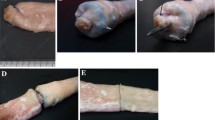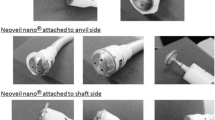Abstract
There are scant experimental data directly comparing the healing of the circular-stapled (CS) anastomotic technique with the standard Czerny-Lembert two-layer handsewn (HS) anastomotic technique during the acute and chronic phases of healing. The purpose of this study, therefore, was to serially evaluate wound healing in CS and HS anastomoses in the normal porcine colorectum. Forty-two adult female mixed-breed pigs randomly under-went either HS or CS anastomosis at the sacral promontory. Laser Doppler velocimetry (LDV) was used to measure perianastomotic blood flow. Groups of animals under-went a second surgery at 3, 5, 11, 60, or 120 days postoperatively, and anastomoses were restudied using LDV, gross and microscopic grading of inflammation, bursting pressures, and hydroxyproline content. Additionally, the 60-day and 120-day groups of animals under-went preoperative biplanar barium enemas to identify leaks or stenoses. No significant differences in perianastomotic blood flow between the HS and CS techniques were obtained over the entire 120-day study period. Serial evaluation of wound healing revealed no significant differences between the two anastomotic techniques with respect to bursting pressures, gross or microscopic inflammatory scores, or hydroxyproline content. There were no leaks or stenoses with either technique. Despite earlier reports to the contrary, there appears to be no fundamental difference in the mode of healing in the porcine colorectum comparing the HS technique with the CS technique.
Similar content being viewed by others
References
Travers B. An inquiry into the process of nature in repairing injuries of the intestines. London: Longman, 1812;128–75, 180–89.
Lembert A. Memoire sur l'enterographic. Rep Gen d'Anat et de Physiol Pathol II 1826;II:101.
Connell ME. An experimental contribution looking to an improved technique in enterorrhaphy, whereby the number of knots is reduced to two or even one. Med Record 1912;42:335–7.
Graffner HO, Andersson L, Lowenhielm P, Walther B. The healing process of anastomoses of the colon. Dis Colon Rectum 1984;27:767–71.
Ravitch MM, Canalis F, Weinshelbaum A, McCormick J. Studies on intestinal healing: III. Observations in everting intestinal anastomoses. Ann Surg 1967;166:670–80.
Guide for Care and Use of Laboratory Animals and Principles for Use of Animals. United States Department of Health and Human Services Public Health Service. National Institutes of Health. Prepared by the Commission on Care and Use of Laboratory Animals of the Institute of Laboratory Animal Resources Commission on Life Sciences. National Research Council; 1985.
Woessner JF. The determination of hydroxyproline in tissue and protein samples containing small proportions of this imino acid. Arch Biochem Biophys 1961;93:440–7.
Vital and Health Statistics, 1986. National Institutes of Health, Department of Health and Human Services.
Silverberg E, Lubera J. Cancer statistics, 1989. CA 1989;39:3–20.
Graffner H, Fredlund P, Olsse S, Osearson J, Petersson B. Protective colostomy in low anterior resection of the rectum using the EEA stapling instrument. Dis Colon Rectum 1983;26:87–90.
Reilling RD, Reilling WA, Bernie WA, Hutler AB, Perkins NC, Elliot DW. Prospective controlled study of gastrointestinal stapled anastomoses. Am J Surg 1980;139:147–52.
Scher KS, Conner CS, Jones CW, Leech RW. A comparison of stapled and sutured anastomoses in colonic operations. Surg Gynecol Obstet 1982;135:489–93.
Elliot TE, Albertazzi VJ, Danto LA. Stenosis after stapler anastomosis. Am J Surg 1977;133:750–1.
Polglase AL, Hughes ESR, McDermott FT, Pihl E, Burke FR. A comparison of end-to-end staple and suture colorectal anastomosis in the dog. Surg Gynecol Obstet 1981;152:792–6.
Buchmann P, Schneider K, Gebbers J. Fibrosis of experimental colonic anastomosis in dogs after EEA stapling or suturing. Dis Colon Rectum 1983;26:217–20.
Waxman BP, Ramsay AH. The effect of stapler diameter and proximal colostomy on narrowing at experimental circular stapled large bowel anastomoses. Aust N Z J Surg 1986;56:797–801.
Weiss P. The biological foundations of wound repair. Harvey Lecture, 1959–60 1961;55:13–42.
Peacock EE Jr, VanWinkle W. Wound repair. 2nd ed. Philadelphia: WB Saunders, 1976.
Chung RS. Blood flow in colonic anastomoses. Ann Surg 1987;206:335–9.
Chung RS, Hitch DC, Armstrong DN. The role of tissue ischemia in the pathogenesis of anastomotic stricture. Surgery 1988;104:824–9.
Author information
Authors and Affiliations
Additional information
This study was supported by a grant from the United States Surgical Corporation (Norwalk, CT).
About this article
Cite this article
Senagore, A., Milsom, J.W., Walshaw, R.K. et al. Direct comparison between Czerny-Lembert and circular-stapled anastomotic techniques in colorectal anastomosis: A similar pattern of healing for both. Dis Colon Rectum 35, 862–869 (1992). https://doi.org/10.1007/BF02047874
Issue Date:
DOI: https://doi.org/10.1007/BF02047874




